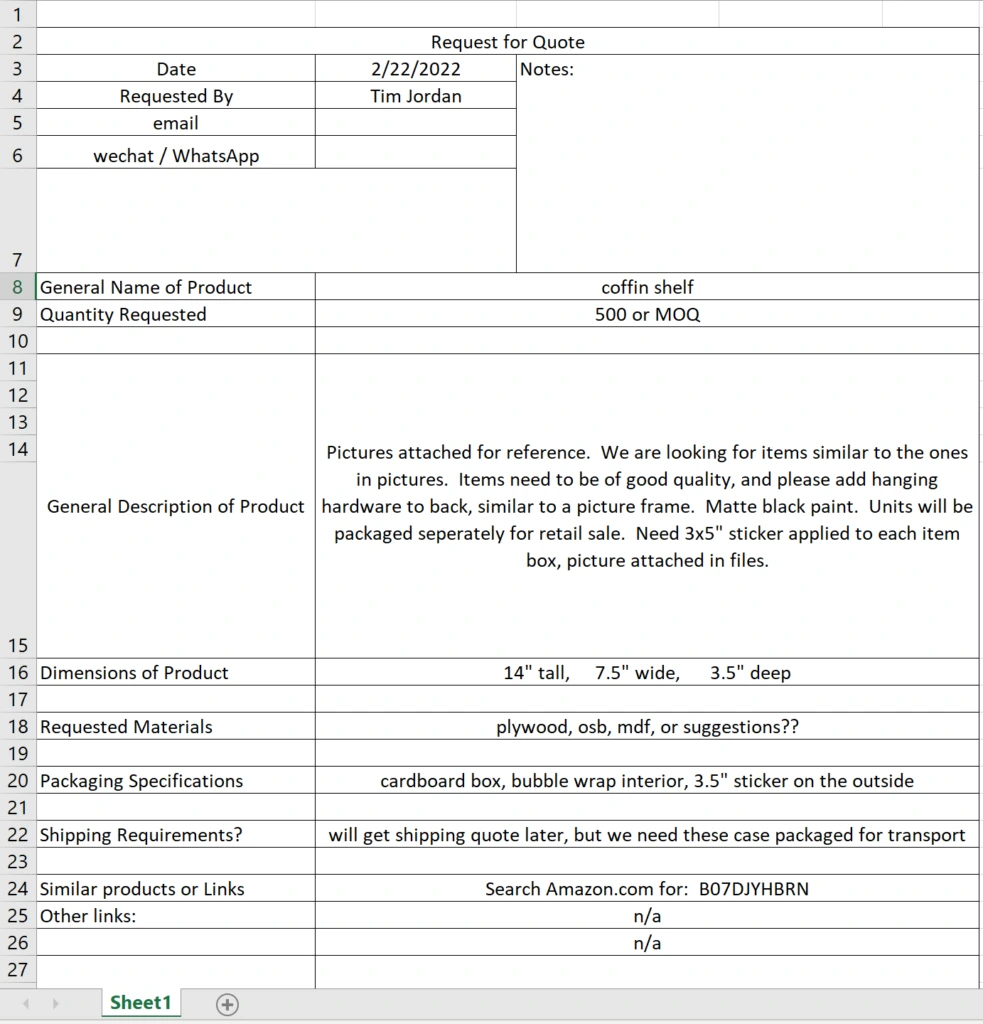
How to Communicate with Foreign Suppliers

Table of Contents
- The Cost of Miscommunication
- Over-Communicate in Your RFQ
- RFQ Product Description
- Dimensions
- Leave Your Supplier Room to Communicate Back
- Give Them References
- Say Things in More Than One Way
- Cultural Differences
- Show an Interest in Visiting Your Source in Person
For many of us, selling on Amazon is a game of numbers… as it should be! At Helium 10 we like numbers. There’s a whole lot of them and they never lie. However, today we’re here to talk about the aspects of running an Amazon FBA business that can’t be solved with a calculator: communicating with your product suppliers.
We are going to focus on language barriers, cultural differences, and overcoming “the vague plague” (more on this later).
Communicating clearly when you are conducting business is challenging enough without these factors. With so much shared every hour of every day, crucial information is bound to get dropped through the cracks. Add in the emotional cocktail of personal opinions and relationships and you have a recipe for miscommunication. Simply telling someone what you want has become… not-so-simple.

The Cost of Miscommunication
A survey of companies with 100 employees revealed average losses of $420,000 every year due to inadequate communication.
Now, as an Amazon FBA seller you are not quite operating a 100 employee business. However, this statistic does still illustrate something important:
Miscommunication isn’t free.

Communication is the backbone of any business, no matter the size.
- You must confidently communicate your brand’s voice to your target audience
- You must visually communicate the intent of your product through photography and other media.
- You must delicately communicate with customers to get feedback from them as well as provide customer service for them.
- You must clearly communicate with your supplier to produce a quality product and source that product in the most economically efficient way possible.
As of 2018, China makes up over 28% of the world’s manufacturing output, the global leader. With good reason – cheaper manufacturing costs and the ability to produce products in bulk make foreign suppliers like China an attractive option for private label sellers. However, for solopreneurs, doing business with foreign manufacturers often means communication is about as clear as mud.
Use the following strategies to improve communication with your Amazon product suppliers and ensure that success truly translates.
Over-Communicate in Your RFQ
Your RFQ or “Request for Quote” is the document that will begin your relationship with your supplier – your intent needs to be abundantly clear.
Before you even begin, make sure to include your name and multiple ways to contact you. If something goes wrong or there is confusion on the manufacturing side, your supplier needs to know how to get in touch with you. We suggest not only using a personal means of communication but also looking into a more universal texting app such as WhatsApp or WeChat. Many of these communication apps are already very popular in international markets like China and have built-in translation capabilities.
On your RFQ (which can be created in a simple Excel spreadsheet) it’s a good idea to lead off with the title of your product. This would normally seem self-explanatory. Remember, all of this information needs to be translated by your international supplier. Yes, you may think your product pictures are worth a thousand words, but you need to be eliminating any potential issues with your order before they occur.
The best way to eliminate logistical issues is to eliminate doubt.
RFQ Product Description
This is where you’ll want to be as specific as possible. Gloss paint or matte paint? Is there any smaller hardware that needs to be included? Does each unit need to be packaged separately for retail sale?
By including this level of specificity in your RFQ you are decreasing the likelihood of future back-and-forths with your supplier where they may try to tack on extra fees for things you didn’t ask for in your original order.
Dimensions

The United States is a trendsetter in many ways… standard units of measurement aren’t one of them. The rest of the world uses the metric system, not inches and feet. If you do not specify exactly what your product dimensions are, expect a comically large prototype from your first order.
If your product is 8 inches tall, 4 inches wide, and 2 inches deep do not list its dimensions as simply 8 x 4 x 2.
List it as: 8” tall, 4” wide, 2” deep.
Leave Your Supplier Room to Communicate Back
Two great places to do this are in your requested quantity and requested materials. You may have a clear idea of what you want for your product but remember to take into consideration your supplier’s requirements and expertise.
Many manufactures have an MOQ or Minimum Order Quantity they require. By strictly putting the quantity you desire, you run the risk of suppliers ignoring your RFQ completely. You want 1,000 units? Great. Write 1,000 units or MOQ. Your supplier will appreciate your willingness to work with them.
Same thing goes for your requested materials. It’s perfectly acceptable to include some suggested materials but your supplier may have something equally sturdy and more price effective. Include that you are open to suggestions to let your supplier know you’re open to learning from their experience.
Give Them References
Don’t be afraid to include reference links of similar products to what you are aiming to produce. These links can be from:
- Google Images
- Etsy
- Other Amazon listings
People are visual learners and often a couple reference links can help overcome some language barriers.
Don’t forget, you are trying to build a relationship with your supplier.
Even though you are over-communicating and being specific, make sure your RFQ remains professional in content and presentation. They are vetting you just as much as you are vetting them. Show them that you are worth giving a quote to and doing business with. Good faith goes a long way, especially when doing business over great distances.
Check out this example RFQ form:

To learn more about what to include with your RFQ and to get a deeper look into navigating sourcing in international waters, check out Project X, Episode 7.
Say Things in More Than One Way
When you are conversing with your supplier or potential supplier about your product, try to get in the habit of always saying things twice – that is, say it in two different ways.
For example, in one sentence it’s a “lamp,” in another a “light fixture.” Really hammer it home what you’re talking about. This has nothing to do with the intelligence of your manufacturer. But how do you know if “lamp” in English translate to “lamp”, “light bulb”, or “hanging light” in their language? Best to leave no doubt.
Cultural Differences

Whichever country your eventual supplier resides in, put some time aside to research cultural tendencies and habits of that country.
Going out of your way to pick up a few traditions or cultural communication “quirks” will:
- Help you to better understand each other
- Be a welcome surprise to your supplier and help strengthen your relationship.
As an example, let’s look at China, the most popular destination for US manufacturing.
In Chinese culture the meaning of the word “yes” is treated a little differently than in the US. The affirmation is used frequently as it helps define their respectful culture, especially present in business. You may hear it more than you are accustomed to. Additionally, yes may not always mean yes. Sometimes, yes means “I understand” or “I hear you.”
“Yes” and “no” are arguably the most important words in the business world. With the above knowledge, you will avoid miscommunications of disastrous proportions.
Show an Interest in Visiting Your Source in Person
According to Amazon sourcing expert Kian Golzari, one of the best ways to begin a relationship with a new factory is to ask them: “When would be a good time to come visit in person?”
Even if you don’t have firm plans to travel to China, for example, consider the positive implications of asking this question.
- It shows you’re serious – factories like to see you are invested in the relationship.
- It puts accountability on the factory to give you better service and be transparent about what they offer, since you may come see for yourself…
- You may learn valuable information – Chinese New Year/other holidays, high season, low season, etc.
Factories really respect buyers who come to their place of business, who have made a long journey from wherever they are in the world.

For more questions you should be asking foreign suppliers, check out Kian’s full video here.
“Please”, “thank you”, and “I appreciate this” all go a long way. Put your best foot forward in building these relationships. Eventually you will want to visit your supplier in person. Help them put a face to the name and the product they are producing for you.
What’s more, as you strengthen these relationships with international manufacturers, this may open up opportunities to learn about some insider info, upcoming trends, or price breaks that you may have never discovered on your own.
To effectively communicate, we must realize that we are all different in the way we perceive the world and use this understanding as a guide to our communication with others.
Tony Robbins
Achieve More Results in Less Time
Accelerate the Growth of Your Business, Brand or Agency
Maximize your results and drive success faster with Helium 10’s full suite of Amazon and Walmart solutions.